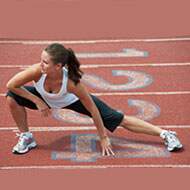- Arm Stretches
- Chest Stretches
- Shoulder Stretches
- Leg Stretches
- Knee Stretches
- Lower Back Stretches
- Hamstring Stretches
- Running Stretches
- Back Stretches
- Thigh Stretches
- Groin Stretches
- Neck Stretches
- Glute Stretches
- Hip Stretches
- Golfers Stretches
- Calf Muscles Stretches
- Ankle Stretches
- Iliotibial Band Stretches
- Piriformis Stretches
- Warm Up Stretches
- Dynamic Warm Up Stretches
- Soleus Stretch
- Gastrocnemius Stretch
- Lumbar Stretches
- Quadricep Stretches
- Ballistic Stretching
- Bicep Stretch
- Triceps Stretch
- Spine Stretches
- Upper Back Stretches
- Abdominal Stretches
- Types of Stretching
Adductor Stretch
The adductors are a group of muscles (Pectineus, Magnus, Gracilis, Brevis and Longus) situated in our groin between the inner pelvis and inner thigh bone. They draw our legs together and help in hip movement.
If you are into sports like running, swimming, sprinting and the lige, make sure to warm up with adductor stretch exercises. Strong adductor muscles save you from developing groin pull strains and groin stretches.
You can start your stretches with the hip adductor stretch.
- Sit on the floor and keep your back upright.
- Hold your ankles and put the soles of your feet together in front. You will feel a stretch in your inner thighs when you try to relax your legs towards the floor.
- Gently, take the stretch further by placing the elbows on top of your knees.
- Ease your body forward from your hips, while keeping your back straight.
- Hold for 10-15 seconds.
- You could also ease the stretch further once you get used to the strain.
This should then be followed by the second stretch.
- In the second stretch, first squat on the floor.
- Place your elbows in your inner thighs and push down your upper body weight on the elbows.
- Use your elbows to stretch the adductor muscles in your inner thigh gently.
There are a few simple and useful standing adductor stretch exercises.
- Spread your legs to about shoulder-width and stand straight.
- Bend one leg and shift body to that side till you feel the inner thigh stretch in the straight leg.
- Hold for about 30 seconds.
The standing adductor stretch with ball improves flexibility.
- Place your right knee on a stability ball and hold your balance.
- Try to spread your leg to the side gently until you feel the stretch.
- Hold for about 10-15 seconds.
Prasarita Padottan-asana is an intense adductor stretch yoga.
- Tighten your legs and keep them around 4 feet apart.
- Inhale and lift hands straight over your head; exhale and bend down to touch the floor keeping hands parallel to each other.
- Hold the position and take breadths; try to bend your head closer to the ground while exhaling.
- Stretch till you feel the strain and slowly get up while inhaling
Types of Adductor Stretch
Whether you are a lay man, or a serious athlete, there are varying types of adductor stretches to suit your physical limits. They are:
- Hip Adductor Stretch
- Adductor Stretch Yoga exercises (Prasarita Padottanasana)
- Long Adductor Stretch
- Standing Adductor Stretch
combinations those of which are explained above. It could be tough to stretch your adductors so it is best to do the stretches slowly. For the long adductor stretch
- sit on the floor and spread your legs apart.
- Keep your back upright and gently bend forward.
- Hold on for 15 seconds.
Adductor Stretch : Do’s And Don’ts
Do's:
- Warm up for 5 minutes before adductor stretching
- Stretch within your physical limits
- Be slow with stretching to avoid injury
- Take your time, be patient
- Concentrate on your breathing, stay relaxed
Don'ts:
- Never bounce while stretching
- Breathe normally, never hold your breath while stretching
- Do not stretch yourself beyond the natural range of a muscle
- Never overdo; you could get muscle stretch reflex
The hip can rotate, expand, contract and adduct so stretching the hip will improve your flexibility but will tighten if you do not exercise. The hip consists of muscles, bones, tendons and ligaments and is a ball and socket joint. The hip muscles are hamstring, iliopsoas, rectus femoris (quad muscle) and gluteus (butt muscles). It is important that you follow the instructions of your trainer while doing the stretches.
Adductor Stretch Benefits
- The adductor muscles are often overstretched. Stretching exercises reduces muscle tension and the range of joint movements increases leading to healthier muscular coordination.
- The blood circulation and digestion improves and you are left with enhanced energy levels.
- The exercises can also avoid a painful medical condition called sciatica. This happens due to tension in the butt muscles (Gluteus maximus or glut) where the sciatic nerve gets pressurized.



